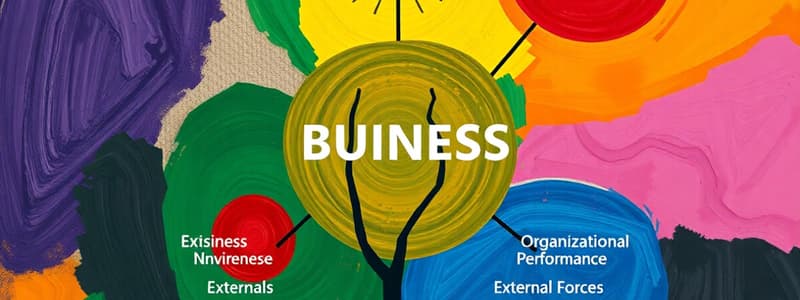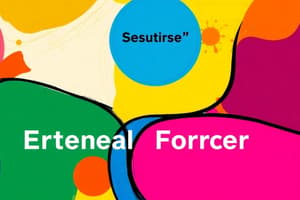Podcast
Questions and Answers
What best describes environmental uncertainty in an organization?
What best describes environmental uncertainty in an organization?
- The stability of market demand for products and services.
- The level of governmental interference in business operations.
- The consistency of organizational policies and procedures.
- The degree of change and complexity in the external environment. (correct)
Which factor does NOT belong to the general environment affecting all organizations?
Which factor does NOT belong to the general environment affecting all organizations?
- Customer preferences for specific products. (correct)
- Economic conditions such as inflation.
- Legal frameworks influencing competition.
- Technological advancements in production.
Which of the following is an aspect of the socio-cultural environment?
Which of the following is an aspect of the socio-cultural environment?
- The stability of exchange rates and inflation.
- Technological innovations in product development.
- Traditions and lifestyles of the population. (correct)
- Government regulations on business practices.
In an international PESTEL analysis, what does the 'E' stand for?
In an international PESTEL analysis, what does the 'E' stand for?
Which component is NOT considered part of the competitive environment?
Which component is NOT considered part of the competitive environment?
What is a characteristic of the technological environment?
What is a characteristic of the technological environment?
Which factor influences both the economic and international aspects of the general environment?
Which factor influences both the economic and international aspects of the general environment?
Which of the following best describes demographic factors in the general environment?
Which of the following best describes demographic factors in the general environment?
What is the primary effect of high rivalry among competitors in an industry?
What is the primary effect of high rivalry among competitors in an industry?
Which factor contributes to the bargaining power of suppliers?
Which factor contributes to the bargaining power of suppliers?
What signifies a strong organizational culture?
What signifies a strong organizational culture?
Which of the following does NOT represent a dimension of organizational culture?
Which of the following does NOT represent a dimension of organizational culture?
Which factor affects the intensity of rivalry among competitors?
Which factor affects the intensity of rivalry among competitors?
What role do stories play in organizational culture?
What role do stories play in organizational culture?
Which of the following best defines the concept of external stakeholders?
Which of the following best defines the concept of external stakeholders?
What is NOT typically a benefit that employees expect from their organization?
What is NOT typically a benefit that employees expect from their organization?
How are the original values of an organization's culture primarily established?
How are the original values of an organization's culture primarily established?
What impact does the threat of substitutes have on an industry?
What impact does the threat of substitutes have on an industry?
Which characteristic best indicates weak organizational culture?
Which characteristic best indicates weak organizational culture?
Which statement is true regarding barriers to entry in an industry?
Which statement is true regarding barriers to entry in an industry?
What is the major impact of top managers on organizational culture?
What is the major impact of top managers on organizational culture?
Flashcards
Business Environment
Business Environment
Factors outside an organization that can affect its performance, such as political, economic, socio-cultural, technological, environmental, and legal influences.
Environmental Uncertainty
Environmental Uncertainty
The degree of change and complexity in an organization's surrounding environment.
Degree of Change
Degree of Change
The rate at which the elements of the external environment change and evolve. A high degree of change means rapid and unpredictable changes.
Complexity
Complexity
Signup and view all the flashcards
General Environment
General Environment
Signup and view all the flashcards
Competitive Environment
Competitive Environment
Signup and view all the flashcards
Economic Forces
Economic Forces
Signup and view all the flashcards
Technological Forces
Technological Forces
Signup and view all the flashcards
Porter's Five Forces Model
Porter's Five Forces Model
Signup and view all the flashcards
Rivalry Among Competitors
Rivalry Among Competitors
Signup and view all the flashcards
Threat of New Entrants
Threat of New Entrants
Signup and view all the flashcards
Bargaining Power of Suppliers
Bargaining Power of Suppliers
Signup and view all the flashcards
Bargaining Power of Buyers
Bargaining Power of Buyers
Signup and view all the flashcards
Threat of Substitutes
Threat of Substitutes
Signup and view all the flashcards
Organizational Culture
Organizational Culture
Signup and view all the flashcards
Strong Culture
Strong Culture
Signup and view all the flashcards
Weak Culture
Weak Culture
Signup and view all the flashcards
Visible Artefacts
Visible Artefacts
Signup and view all the flashcards
Invisible Culture
Invisible Culture
Signup and view all the flashcards
Adaptability
Adaptability
Signup and view all the flashcards
Stakeholders
Stakeholders
Signup and view all the flashcards
Study Notes
Business Environment
- Environment encompasses external forces impacting organizational performance.
- Environmental uncertainty is defined by change and complexity. Change refers to how frequently components shift, while complexity signifies the number of environmental components and how well understood they are.
General Environment
- Broad external forces affecting all organizations.
- Includes political, economic, socio-cultural, technological, environmental, and legal factors.
Competitive Environment
- Industry-specific factors impacting an organization.
- Comprises customers, suppliers, and competitors.
Major Forces in the General Environment
- Economic: Interest rates, inflation, unemployment, and economic growth.
- Technological: Infrastructure, innovations, and changes in production/distribution tech.
- Political and Legal: Political stability, government regulation, and legal changes.
- Socio-cultural: Customs, values, traditions, beliefs, and behaviors.
- Demographic: Population characteristics (age, gender, ethnicity, etc.).
- Environmental: Environmental pollution, sustainable practices, and climate change.
- International: Involvement in and impact from international business activity.
International PESTEL Analysis
- Political: Government views on foreign investment, political stability, and intellectual property regulations.
- Economic: Growth rates, wealth distribution, currency stability, and exchange rates.
- Socio-cultural: National cultures, and attitudes towards foreign entities.
- Technological: Telecommunications, power supply stability, transport infrastructure.
- Environmental: Natural resources, environment quality, and climate change.
- Legal: Tariff policies, trade agreements, employment protection, and taxation.
Competitive Environment Details
- Suppliers: Provide input resources for production.
- Distributors: Help organizations sell to customers.
- Customers: Individuals/groups purchasing produced goods/services.
- Competitors: Produce similar goods/services.
Porter's Five Forces Model
- Analyzes industry attractiveness.
- Rivalry among competitors: High rivalry = lower industry profits. Factors include number of competitors, demand growth, product differentiation, and exit barriers.
- Threat of new entrants: Low barriers = lower industry profits. Barriers include capital requirements, economies of scale, and customer loyalty.
- Bargaining power of suppliers: High supplier power = lower industry profits. Factors include the number of suppliers, the customer's purchasing habits, ability for suppliers to compete with customers, and cost of switching suppliers.
- Bargaining power of buyers: High buyer power = lower industry profits.
- Threat of substitutes: Similar products from other industries.
Organizational Culture
- Shared values, principles, and ways of operating.
- Distinguishes an organization.
- Strong culture: Shared values, employee identification, and storytelling.
- Weak culture: Values limited to top management, no employee identification, contradictory messages.
Levels of Organizational Culture
- Visible artefacts: Observable aspects (dress, behavior, symbols, ceremonies, layout).
- Invisible: Values/beliefs (interpreted from stories/language/symbols); underlying assumptions (role models, legends).
Dimensions of Organizational Culture
- Adaptability
- Attention to detail
- Outcome orientation
- People orientation
- Team orientation
- Integrity
Establishing Organizational Culture
- Founders' vision
- Transmission through stories, symbols, and language
- Maintenance through selection and socialization practices
- Top management actions
Stakeholders
- Individuals/groups with interest in a company.
- External stakeholders: Customers, suppliers, creditors, governments, unions, communities, general public
- Internal stakeholders: Stockholders, employees, managers, senior execs, and board members.
Stakeholder Claims
- Stockholders: Maximize return on investment.
- Managers: Pursue best stakeholder benefits and utilize resources efficiently.
- Employees: Expect rewards for performance.
- Suppliers: Fair and prompt payment.
- Distributors: Quality products at agreed-upon prices.
- Customers: Attraction to stay in business.
- Communities: Provide infrastructure for company operation.
Studying That Suits You
Use AI to generate personalized quizzes and flashcards to suit your learning preferences.




